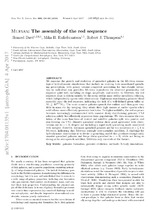| dc.contributor.author | Dave, Romeel | |
| dc.contributor.author | Rafieferantso, Mika H. | |
| dc.contributor.author | Thompson, Robert J. | |
| dc.date.accessioned | 2017-04-22T10:01:54Z | |
| dc.date.available | 2017-04-22T10:01:54Z | |
| dc.date.issued | 2017 | |
| dc.identifier.citation | Davé, R. et al. (2017). Mufasa: The assembly of the red sequence. Monthly Notices of the Royal Astronomical Society. | en_US |
| dc.identifier.issn | 0035-8711 | |
| dc.identifier.uri | http://hdl.handle.net/10566/2747 | |
| dc.identifier.uri | https://arxiv.org/abs/1704.01135 | |
| dc.description.abstract | We examine the growth and evolution of quenched galaxies in the Mufasa cosmo-
logical hydrodynamic simulations that include an evolving halo mass-based quench-
ing prescription, with galaxy colours computed accounting for line-of-sight extinc-
tion to individual star particles. Mufasa reproduces the observed present-day red
sequence quite well, including its slope, amplitude, and scatter. In Mufasa, the red
sequence slope is driven entirely by the steep stellar mass{stellar metallicity relation,
which independently agrees with observations. High-mass star-forming galaxies blend
smoothly onto the red sequence, indicating the lack of a well-de ned green valley at
M & 1010:5M . The most massive galaxies quench the earliest and then grow very
little in mass via dry merging; they attain their high masses at earlier epochs when
cold in
ows more e ectively penetrate hot halos. To higher redshifts, the red sequence
becomes increasingly contaminated with massive dusty star-forming galaxies; UVJ
selection subtly but e ectively separates these populations. We then examine the evo-
lution of the mass functions of central and satellite galaxies split into passive and
star-forming via UVJ. Massive quenched systems show good agreement with obser-
vations out to z 2, despite not including a rapid early quenching mode associated
with mergers. However, low-mass quenched galaxies are far too numerous at z . 1 in
Mufasa, indicating that Mufasa strongly over-quenches satellites. A challenge for
hydrodynamic simulations is to devise a quenching model that produces enough early
massive quenched galaxies and keeps them quenched to z = 0, while not being so
strong as to over-quench satellites; Mufasa only succeeds at the former. | en_US |
| dc.language.iso | en | en_US |
| dc.publisher | Oxford University Press | en_US |
| dc.rights | This article has been accepted for publication in Monthly Notices of the Royal Astronomical Society ©: 2017 Published by Oxford University Press on behalf of the Royal Astronomical Society. All rights reserved. In accordance with author self-archiving policy, to view the article online visit: https://arxiv.org/abs/1704.01135 | |
| dc.subject | Galaxies | en_US |
| dc.subject | Formation | en_US |
| dc.subject | Evolution | en_US |
| dc.subject | N-body simulations | en_US |
| dc.title | Mufasa: The assembly of the red sequence | en_US |
| dc.type | Article | en_US |
| dc.privacy.showsubmitter | FALSE | |
| dc.status.ispeerreviewed | TRUE | |
| dc.description.accreditation | ISI | en_US |

